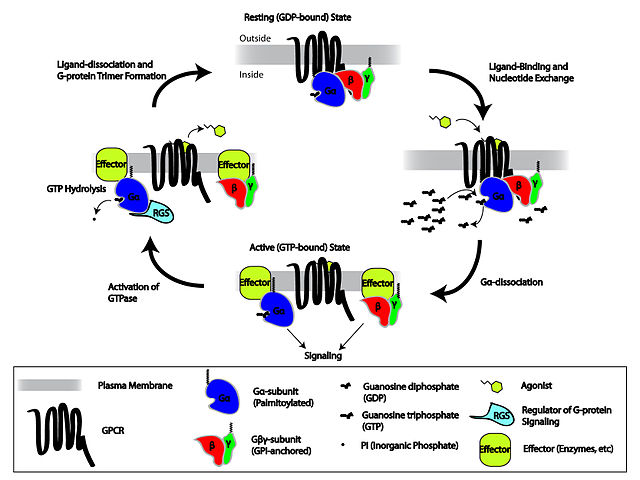 Daily Newsletter
Daily Newsletter
September 20, 2012 Direct vs. Indirect Signals
Signal transduction involves a signal contacting an appropriate receptor which ellicits a cellular effect. The transduction is thus the changing of signal into an effect. Transduction can be either direct or indirect.
A direct transduction event implies that the receptor ellicits an immediate effect on the cell. A good example of this is the Androgen (Testosterone) Receptor. The image below is a good image of the basic signal transduction pathway. Testosterone is lipid soluble, so can easily move through the membrane. Once inside of the cell, it is changed to dihydroxytestosterone (DHT). This binds to the receptor, and then the receptor-ligand complex is moved into the nucleus. Inside of the nucleus it directly affects the transcription of genes. In this case, the receptor-ligand complex has a direct effect on the cell.

Indirect signal transduction will involve the creation of a secondary messanger. The receptor-ligand complex will create a condition where an intracellular chemical signal is created. One primary signal binding to the receptor can then be amplified within the cell by creating this secondary messanger. Below is a general diagram showing the use of a G-Protein interface. The Ligand-Receptor complex directly activates the G-Protein. The activated complex then activates a specific effector in the cell membrane.

In the above image, there are four views of the Receptor-G-Protein complex. In the top image of the cycle, the Resting State, there is no ligand bound to the receptor. When the ligand binds (the next image in the cycle), GTP binds to the Gα subunit. This causes the Gα subunit to detach from the rest of the G-protein (Gβγ Subunit). The subunits then bind to Effectors.
A very prevelant effector enzyme is Adenylat
 e Cyclase. This enzyme takes ATP (Adenosine Triphosphate) and removes two phosphates. The remaining phosphate binds back to the ribose sugar at the 3' carbon, creating a ring structure (cycle) between carbon 5' and 3'. This is known as cyclic AMP (cAMP). cAMP is a very common secondary messanger. It can be produced in bulk and can bind to a variety of enzymes. Many kinases (enzymes that add phosphates to other proteins, aka phosphorylation) are activated/deactivated by cAMP. So eukaryotic cells use this system to amplify the original signal to produce a large number of cAMP in order to affect protein activiation.
e Cyclase. This enzyme takes ATP (Adenosine Triphosphate) and removes two phosphates. The remaining phosphate binds back to the ribose sugar at the 3' carbon, creating a ring structure (cycle) between carbon 5' and 3'. This is known as cyclic AMP (cAMP). cAMP is a very common secondary messanger. It can be produced in bulk and can bind to a variety of enzymes. Many kinases (enzymes that add phosphates to other proteins, aka phosphorylation) are activated/deactivated by cAMP. So eukaryotic cells use this system to amplify the original signal to produce a large number of cAMP in order to affect protein activiation.Why would phosphorylation affect protein activiation? Phosphates are large with a -2 charge. Binding a phosphate to a protein will force the protein to change shape (configurational change).
Below is an example of indirect signal transduction via a G-protein:

Daily Challenge
Using Testosterone and Epinephrine as examples, explain the difference between direct and indirect signal transductionLink to Forum
Reference
The image of Epinephrine stimulated cAMP synthesis comes from Encyclopedia Britanica.Encyclopedia Britanica. (2008). Epinephrine-stimulated cAMP synthesis. Encyclopedia Britanica, http://www.britannica.com/EBchecked/topic/1522055/G-protein-coupled-receptor-GPCR?overlay=true&assemblyId=124084, accessed September 12, 2012.
Other images are from Wikipedia Commons with the full reference embedded as a pop-out, or have the reference shown in the image.
No comments:
Post a Comment